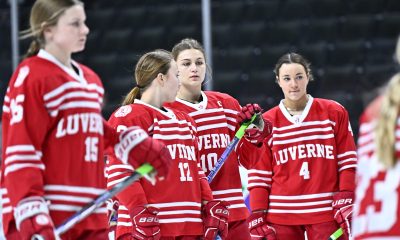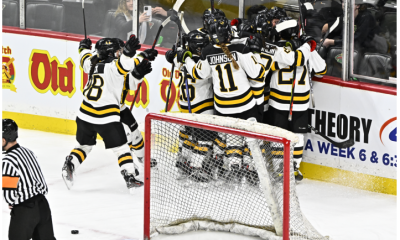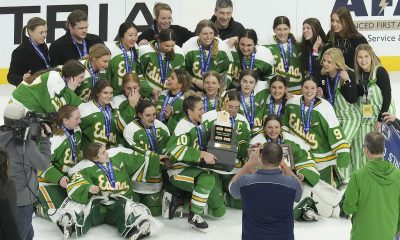Girls
Packers a reflection of their coach
Palmquist, South St. Paul mirror girls’ prep hockey success
-
by
Brian Jerzak
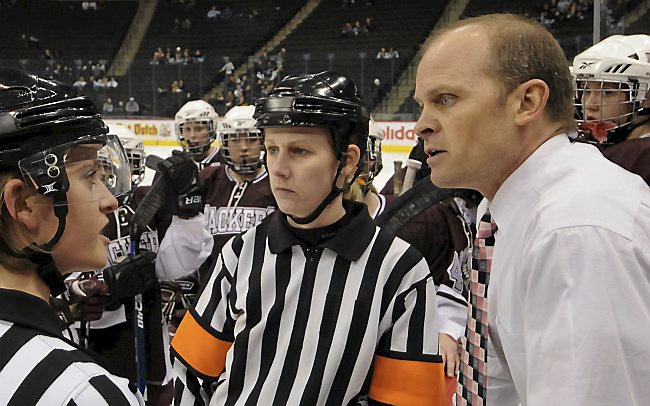
Palmquist, South St. Paul mirror girls’ prep hockey success
This is the 21st year girls’ hockey has been a State High School League sanctioned activity. For all 21 years, the South St. Paul Packers have had the same head coach – Dave Palmquist. Palmquist, who started his coaching career in the boys’ game, won career game No. 500 last season. His successful career has in many ways mirrored the continued growth of the girls’ game.
Palmquist grew up in Hibbing, but after his family moved south, played as a youth in the Columbia Heights system before playing his high school hockey for Bruce Hendrickson at Minnehaha Academy.
A center most of his career, Palmquist graduated from Minnehaha and played for Craig Dahl at Bethel before returning to his al ma mater. Hendrickson knew his former player wanted to get into coaching so Palmquist was hired as an assistant. He served as an assistant coach for one year and just two years out of college was named Minnehaha Academy’s head coach.
“Doors just kept opening up,” Palmquist said. “At age twenty three I was a head coach and from there it has just been in my blood – something I have a strong passion for. I love the game. I love watching hockey at all levels. I love the teaching part of it. [Coaching hockey] was a natural fit. Never once have I ever felt I was in the wrong profession. It has been a real blessing.”
After down seasons in years two and three, the new head coach built the program into a conference champion. Despite the success and a program moving in the right direction, Palmquist felt it was time for him to make a change.
“It was a tough decision. I loved everything that Minnehaha Academy stood for with Christian faith and the religious background, but I wanted to take on a new challenge.”
Birth of a Program
The boys’ position opened up at South St. Paul and the young coach applied. What happened next was not what Palmquist expected.
“I interviewed and I knew it went pretty well, but they offered the job to someone else. That was the first year they were starting girls’ hockey in Minnesota. [They said] you didn’t get the boys’ job, but we would love you to start our women’s hockey program.”
With the girls’ game just getting off the ground Palmquist wasn’t sure how moving to the girls’ game would sit with his colleagues.
“It was a tough decision, because girls’ hockey was really new,” Palmquist admitted. “I didn’t know what I was getting into. I think a lot of my colleagues in coaching were wondering what I was doing going to the girls’ side. Twenty one years later we can see how many males have gone over to the female side.”
For the game to get off the ground, the Packers’ program needed the same type of support as any of the early programs – passionate parents and hockey fans. South St. Paul had a long hockey tradition so it was an area suited to start a girls’ program.
“South St. Paul is known as a hockey community – always has been,” the former Redhawks’ hockey star said. “Back in those early days we had fathers who were hockey players and hockey stars during their days at South St. Paul. Now they had daughters and they were passionate about making it an awesome experience for their kids. A lot of those dads helped coach in those early years. We were able to get off and running because of those fathers who stepped up and understood the game. We have always had great youth coaches developing kids in those prime years. It makes a huge difference.”
Another advantage South St. Paul had was they had a successful ringette program in the school. There were a number of girls who were going into it as good skaters.
“I didn’t know anything about ringette,” Palmquist admitted, “except that they did skate and they used basically an upside down hockey stick with a ring. They were really good at it. Those girls were really excited to make the change to hockey.”
They could skate, but they needed to learn how to translate what they could do into hockey skills. Palmquist spent a lot of time on the fundamentals. The more the girls’ game changes, the more it stays the same.
“I really had to focus on the skills of hockey – which I am still doing twenty years later – but those first few years teaching them hockey was the focus. I spent a lot of time teaching them what this great game was all about.”
With the checking rules in the girls’ game, if a team can skate, Palmquist and other girls’ hockey coaches have said that good skating teams – even more than the boys, can dominate the puck. In the early days it often just took one or two great players to dominate a game; because of the growth of the sport that has changed.
“I think a lot of coaches would say we have been able to develop more depth on our teams,” the coaching pioneer said. “We have more well rounded teams from the standpoint of not having just one or two superstars.”
The Streak
Most high school hockey fans know about the 86 game winning streak the Packers had from 2001 to 2004. Palmquist’s teams in those days had depth and talent.
“The thing I am most proud of is over twenty years a lot of kids have come and gone, but we have maintained and been a factor for twenty years,” the Bethel Royals graduate reminisced. “That is something I am really proud of. During that run you can’t have a run of 86 games without a loss and four state championships without great players. I was blessed to have group of young players that were special. They were kids with winning attitudes that refused to lose. They were not going to be denied. They had the skill, but they were willing to put the work in to be the best. Something we are proud of is the best teams don’t always win. We may have had the best teams, but they did find a way to win. The girls stepped up to the challenge every time.”
The success of the Packers during those times did a lot to help the growth of the girls’ game, but also might have hurt it.
“It drew hockey to the forefront,” Palmquist said. “The coverage we had from 2000-2005 – our Packer team was on the front page of the Star Tribune and the Pioneer Press when we were winning and when we finally lost too. It brought girls’ hockey to the forefront.”
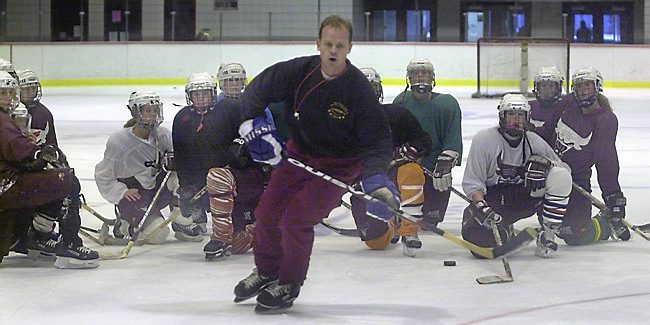
A stickler for fundamentals, South St. Paul girls’ hockey coach Dave Palmquist demonstrates some techniques to his team during a 2001 practice at Wakota Arena. (Pioneer Press file photo)
With a team that dominant, other schools had to build programs under the Packers’ shadow. Still growing programs had to take their lumps against the four-championships-in-five-years Packers. Getting kids to try something new knowing they would have to play a team so far above their skill level couldn’t have made a coach’s job easy when trying to build a program.
“We were a team that a lot of people loved to hate,” Palmquist said.
When they finally lost in the state quarterfinals in 2004 it was like a pressure release valve, at least to the girls playing high school hockey at that time.
“Legend has it that some of the other teams who played later in the evening were at a movie theater and word got out that we lost to end our streak,” Palmquist recalled. “Basically the theatre erupted because they heard we lost.”
Consistent Success
Despite the loss, South St. Paul came back and won the title the next season, showing its resiliency in posting a 30-1 record according to Palmquist. The Packers have been remarkably consistent since.
“The number one thing is that you have to have great players,” Palmquist said. “We also had the same coaches for 18 of these 21 years. You see that in all sports. When you have that consistency in a program – the girls knew what the program was about. That was a big factor in our success having that consistent coaching staff.”
The consistency of the coaching staff allowed the program to adjust, but it took Palmquist some time to realize it was better for him to adjust to the players than make the players adjust to him.
“One of the things I learned early on is knowing what kind of players you have will dictate what kind of system you set up,” the only head coach in Packers’ girls’ hockey history said. “We were scrimmaging in Stillwater in 2002 – the year we won our first state title – we were 2-2 and we were trying a crazy type of forechecking system. We had a lot of talent and I remember turning to Coach [assistant coach Pete] Edlund and saying we are restricting these kids too much. They have too much ability. When we unleashed them and let them just use their ability we proceeded to win 86 in a row. The lesson being you have to read your team. Over the years we have been able to adjust our systems to what fits for that team.”
Palmquist does stick to some basic principles in his coaching, but as a player didn’t always practice what he now preaches.
“In high school and college I didn’t like to come back in my own end a lot,” the former forward said. “We still tell stories about that. Now as a coach it is so different. It is so uncharacteristic of me now because I always preach defense and coming back hard. [As a player] scoring was something that was more on my mind than playing defense that is for sure.”
Always on his mind as a coach has been holding everyone in the program up to a high standard – on and off the ice.
“You have to develop a program that has high expectations and high accountability. I don’t think you can be successful without both. We have built such a tradition at South St. Paul that I feel as a coach I see it as my responsibility to continue demanding accountability and discipline within our program. Play to win, but most importantly I want to develop a place where kids want to come to each day – to the rink and a place where kids are cared about and appreciated.”
“My style is demanding, but I care about my players,” Palmquist continued. “I feel like if I am not demanding and don’t expect the best out of them they won’t reach their potential. I feel like these kids today can do so much more than they think they can. It is my job as a coach to try to bring that out.”
Focus on Family
The coach is also focused on delivering a positive message off the ice.
“We are about developing kids for life. We’ve brought a consistency to the community where they know what we stand for. My faith and my family are important so I stress that to the kids. They know those things are way more important than winning. Their faith and their family are the things that are going to get you through.”
Even on the ice, family is front and center with Palmquist.
“This year I have been so fortunate – my son is coaching with me. We are having a blast this year. My daughter played for me and graduated last year and now I get to coach with my son.”
Josh Palmquist replaced long-time assistant coach Edlund who retired a few seasons ago. Corey McGinn, who is also a South St. Paul graduate, is also part of the staff. Both the younger Palmquist and McGinn work mostly with the forwards while the head man switched his focus from the forwards to the defense.
This season the Packers have not gotten off to the start their fans are used to, but Palmquist believes the pressure to succeed every season helps his program.
“When we lose it is a big deal and that is a good thing. I expect this team to be there at the end even though we started 7-5-1. We have a great goaltender and I believe we will be competitive down the stretch,” Palmquist said. “Four year starter Sidney Connelly is between the pipes. She’s given up something like fourteen goals in eleven games. She works so hard. Anna Barlow has been one of only two girls in my 21 years who has been an impact player since seventh grade. She is a straight A student and a great leader. Taylor Cashman brings a lot of leadership to the team and scoring.”
No one can expect the Packers’ program to reach the absurd levels they reached in the early 2000’s. In order to get this team and future teams to compete at the highest level again is not much different than what the sport has to do to continue growing.
“We still need to work our youth and continually work to make hockey affordable and something that these kids can do and help grow our numbers.”
According to the State High School League, nearly 3,800 young women competed in girls’ hockey last season in Minnesota. The only reason the sport has been able to grow and thrive for twenty one years and counting is because of countless hours of dedication by athletes, parents and coaches like Palmquist.
Brian started his writing career covering high school and college wrestling for The Guillotine. He started covering football for MinnesotaPreps.com shortly after. With MinnesotaPreps he also covered boys’ basketball. Brian has covered boys and girls hockey as well as a number of other high school sports during stints with the Star Tribune and the Minnesota State High School League. Still covering wrestling for The Guillotine, he currently covers high school football for NorthStarFootballNews.com.









